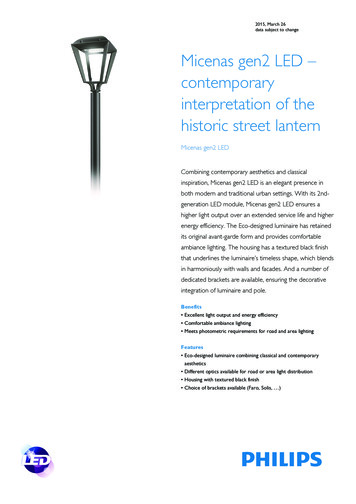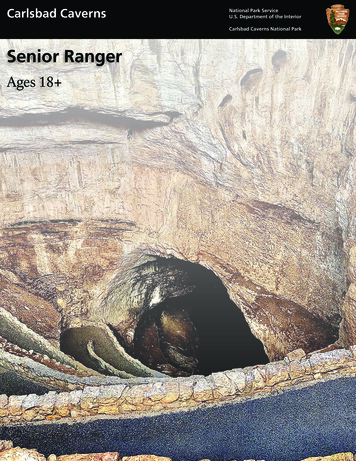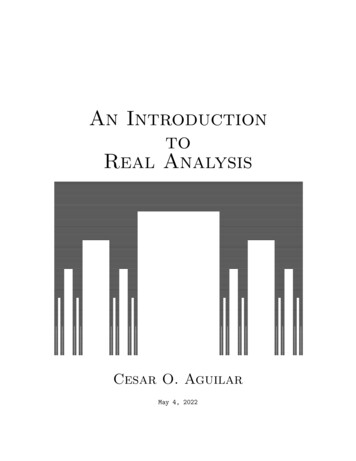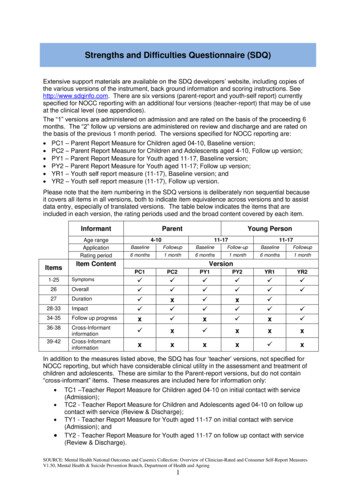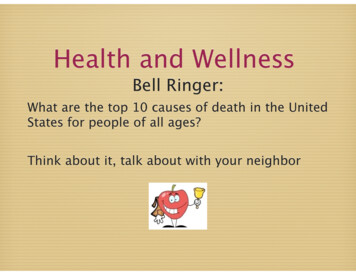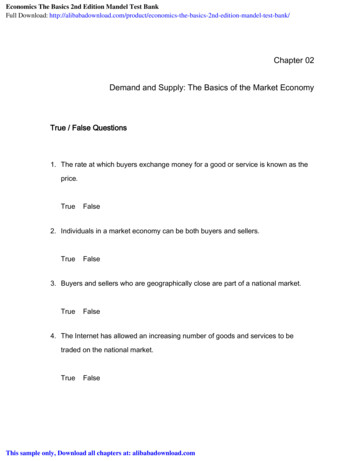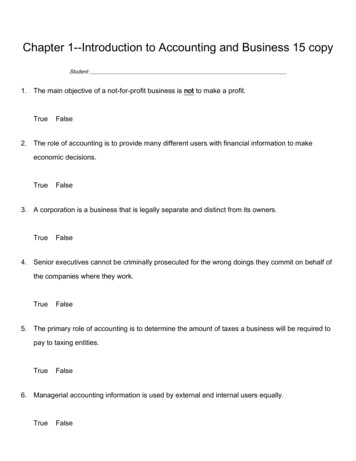
Transcription
“It is certainly not true that there is in themind of Man any universal standard of beautywith respect to the human body”The Descent of Man, and Selection in Relation to Sex (p. 584) by CharlesDarwin, 1871
Examples of Arbitrary CulturalStandards
Arbitrary Cultural Standards
Arbitrary Cultural Standards
Beauty is in the eye of thebeholder, or is it? Thestandard claim is that conceptions ofbeauty are culturally determined andtherefore arbitrary. Research over the last dozen years or soreveals that how we evaluate beauty in thehuman body appears to be based on auniversal set of standards. Therefore, someconceptions of beauty are not culturallydetermined.
What isBeautiful?
Relative and Absolute Standards inAttractiveness Universalmodel: holds that there are absolutestandards that people use to assess attractiveness Assortative model (like attracted to like): holdsthat standards are relative to the viewer. That is,we are attracted to those who are similar to us.Also known as positive assortative mating. We will begin with the universal (or absolute) andfollow with the assortative (or relative) Finally, most of the research has focused onfemale attractiveness
Universal bases for female physicalattractiveness¾General Symmetry: low fluctuating asymmetry (applies tomales also)¾Body form Waist to hip ratio of approximately 0.7 (?)¾Face Average (applies to males also) small lower jaw (nasion to chin) high upper and lower lips small mouth (width) large eyes light skin homogenous skin texture
Symmetry
How symmetry ismeasured
Symmetry measures: 1
Symmetry measures: 2
Symmetry measures: 3
Symmetry measures: 4
Symmetry measures: “What? MeWorry?”
Physical development and symmetry areregulated by: growth rates hormone levels nutrition disease9The level of symmetry is a measure of developmental stability.9Developmental stability is an indication of an individual's ability towithstand genetic and environmental stress during growth.9High FA is very weakly and perhaps inconclusively associatedwith increased morbidity and decreased heterozygosity9It may be the case that modern medicine has broken the relationshipbetween symmetry and health. Research needs to be done onpopulations with poor access to health care to evaluate the utility ofsymmetry as a sign of fitness.
Symmetry is positively associatedwith Stature Tall males less asymmetrical (positive association) Small females less asymmetrical (negative association) IQ Numberof lifetime partners and RS (males &females) Running speed Aggression DepressionSource: JT Manning et al., 2002, Evolution and HumanBehavior
Facial Averageness“Attractive faces are only average”.Langlois & Roggman. PsychologicalScience (1990)
Computing AveragenessSource: TheEvolutionaryPsychologyof FacialBeauty.AnnualReview ofPsychology(2006)GillianRhodes
Examples: creating an average face(Asian)
Creating an average face (N. Amer.)
Average plus reduce jaw and peaked lips leads to aneven more attractive faceLength of nasionto chin in red toindicate smallerlower face.
Averageness is associated withhigh levels of heterozygosity which, inturn, is associated with enhancedpathogen resistance. That is, averagelooking people tend to be healthier. Butthe effect is very moderate and needsfurther study.
Other Factors Associated withAttractiveness FacialSmoothness Skin coloration Specific facial features
Facial smoothness: absence of blemishes andlines indicative of youth. In addition, skindarkens with age.Subject on left retouched to enhance facial homogeneity
Male and Female Differences inSkin Color Menare darker than women Result of heavier concentration of hemoglobinin blood and melanin in skin and thickersubcutaneous fat layer in women Universally, men prefer women who are lighterthan average (relative to local population) andwomen prefer men who are darker thanaverage (relative to local population). But one can be too dark or too light in localpopulation
Skin Color and Attractiveness Frostreports that out of 51 differentcultures in the HRAF, 44 cultures favoredlighter complexions on either only women(30) or on both sexes (14). In only 3cultures was fair skin preferred on menonly, and in just 4 cultures was darker skindesired in women.
Male Attractiveness, Masculinity, andSpecific Facial Features Prominentcheek bones and longer lower faces areboth judged as attractive in males. When these two factors are combined amasculinity index is created, and this index ismore strongly correlated with attractiveness thancheekbone or longer lower face alone. Finally, male facial symmetry and the masculinityindex were correlated.Source: Scheib, Gangstead, and Thornhill“Facial attractiveness, symmetry and cues ofgood genes. Proc. R. Soc Lond. B (1999)
Feminine and Masculine Faces Malesfavor women with feminine faces Small chin and high cheek bones Fuller and more peaked lips Large eyes (relative to face) Femalesfavor males who are slightly tomoderately facially masculine but notextremely so Chins broader and longer Large brow ridge
Body Form: Waist to hip ratioWHR is a reliable index of age, hormonal status,parity, fecundity, and health. Before puberty boysand girls have similar ratios. However, withfemales pelvis widens and fat is deposited on hipsand thighs at puberty. Healthy women have ratiosof 0.67 to 0.80 while healthy men have 0.80 to0.95. For attractiveness, ideal for men is 0.90 andfemale ideal is 0.7 (for Western populations only).
Waist to HipRatio:standardstimulus set
WHR and female mate valueWHR increases with each pregnancy andincreases slightly with age. However, a 17year old will have nearly the same WHR as a22 year woman and at menopause it reachesthe level of a male's WHR (about 1). HighWHR is strongly negatively associated with theprobability of conception and positivelyassociated with age.
Male and female evaluations are parallelbut males place greater emphasis onWHRStreeter, S.A. &McBurney, D.H.(2003) Waist–hip ratio andattractiveness:New evidenceand a critique of"a critical test",Evolution andHumanBehavior, 24,88-98.
WHR ratio and health correlatesHigh WHR in women is a sign of: menstrual irregularity hirsutism (abnormal growth & distribution ofhair) elevated plasma triglycerides diabetes and insulin intolerance hypertension stroke gall bladder disease reproductive cancers (endometrial, ovarian, andbreast)
WHR and Behavioral Correlates inWomen Positively correlated with age of firstintercourse. Negatively correlated with number of lifetime sexual partners and EPC’s,
Examples: both figures have a 0.7 WHR (themore things change, the more they stay thesame)
Further example of WHR’s
WHR of 0.7 a reflection of Westernstandards? Recent research by anthropologists reveals that a WHRratio of about 0.8 is preferred in the following ethnicgroups: HadzaShuarMachiguengaGreater than 0.7 WHR may be a consequence of living in afood short environment which suggests that men areconcerned with energy status when it is relevant (i.e., notrelevant in the West but relevant in tribal populations)BMI: additional research in the West suggests that BMI ismore important. The problem with BMI and WHR is thatthey are strongly correlated with each other. Thus, it isunclear which is the signal of reproductive potential.
Brits &SA ZulusBrit Zulu &SA ZulusBMI/WHRandCulture“Changing perceptions ofattractiveness asobservers areexposed to a differentcultures”B. Martin J. Toveé et al.Evolution and HumanBehavior (2006)Brits of African Origin &Brit Zulus
Local conditions may matterPoverty & Hunger: People in rural South Africa are living in alow-resource, economically deprived society. Fifty-six percentreport going hungry, and most households do not haveelectricity, running water, or significant amounts ofhousehold durable goods. In South Africa a higher femalebody weight is perceived to reflect affluence, high status, andgood health. It is therefore not surprising that our resultssuggest that a higher female BMI is regarded as attractive.Health Problems: These preferences may be reinforced by thecurrent health problems prevalent in South Africa. There arelong-standing problems with infectious diseases, includinglower respiratory tract infections, meningitis, diarrhea,septicemia and TB, which, when combined with low levels ofimmunization, make potential infection a serious possibility.The health consequences linked to these serious diseasesinclude weight loss, and this is reflected in the perceptionthat a lower body mass may signal potential parasiticinfection or disease
SHR: shoulder to hip ratio anintroduction to a male sign Measurement: hip measured as largest circumference aroundthe hips and buttocks. Shoulder measured as greatest width of shouldblades with arms at sides. Results: Men ranged from 1.03 - 1.40, mean of 1.18 Women ranged from 0.9 - 1.22, mean of 1.03SHR 1 of 2
SHR in men: behavioral correlates Negatively correlated with age at first sexualintercourse (narrow shoulders later firstsex) Positively correlated with: reported number of sexual partners; and EPC (extra pair copulations) or cheating on yourown partner (broad shoulders more sex)SHR 2 of 2
Height and Attractiveness Inthe west males prefer females who are shorterthan average while females prefer males who aretaller than average. In the west tall men have higher RS than shortermales and shorter females have higher RS thantaller females. But in rural Gambia this relationship seems not tohold. Tall women had higher fertility & higher survivorship oftheir children While taller men were only very slightly more likely tohave higher RS than shorter menSear “Height and Reproductive Success”. Human Nature 17(4) 2006.
Height in Gambia InGambia tall women are more reproductivelysuccessful (higher fertility) than short women. There is no correlation between height and fertilityamong men. However, taller men contract more marriages thanshorter men. No correlation between height and health forGambian men and for Gambian women the relationship is inverted Ushaped.Sear “Height and reproductive success: how a Gamian population compares to theWest” (2005)
Assortative or relative models: “Selfseeking like” Peoplemarry those who resemble themselves Known as positive assortative mating Correlations for most physical traits (height,weight, hair color, etc.) and many behavioral traits(interests, personality, etc) Two potential explanations for this relationship: Optimizes outbreeding to avoid excessive geneticvariance that would interfere with coadaptive genecomplexes Competition and matching hypothesesSelf seeking 1 of 2
Self perception and mate choice inWestern society Thestandard evolutionary argument is thatmen are attracted to beauty, youthfulness,sexual fidelity, and health while Women are attracted to men who areambitious, wealthy and have high socialstatus But as Mick and Keith note “You can’talways get what you want”Self perception and mate choice in Western society: Buston and Emlen
Potentials attract Thishas led many to successfully predictthat mate choice would be based onreproductive potential. That is attractive women, for example, wouldmatch up with wealthy men. The problem with this argument is that itignores the problem of stability in marriage,a key to RSSelf perception and mate choice in Western society: Buston and Emlen
Marital Stability Ifmate choice were based on reproductivepotential then Reproduction might be delayed waiting for anexceptionally beautiful or wealthy mate. Furthermore, these marriages would beunstable if a more beautiful or more wealthymate came along. One would be tempted to“trade up”.Self perception and mate choice in Western society: Buston and Emlen
Relativism in mate choice Womenlower their self-assessed beautywhen exposed to beautiful women and menlower their self-assessed attractivenesswhen exposed to socially dominant males. In addition, each sex lowers theirassessment of the other when their mateswere compared to more highly ratedmembers of the opposite sexSelf perception and mate choice in Western society: Buston and Emlen
The question Potentialsattract: are choices based on absolutecriteria (e.g., beauty and wealth)? or do likes attract, a relative criteria: how similar arethey to the seeker in a number of crucialdimensions? Ten questions asked that can be divided into 4evolutionary categories: Wealth and statusPhysical attractivenessFidelityFamily commitmentSelf perception and mate choice in Western society: Buston and Emlen
Results I Ifthe potentials model is correct thenattractive women would have had strongerpreferences for wealthier men and viceversa This pattern was observed to be statisticallysignificant but it explained very little of thevariance (around 5%)Self perception and mate choice in Western society: Buston and Emlen
Results II Ifthe likes attract then there should be apositive correlation between self perception(e.g., fidelity or attractiveness) andimportance of that same factor in a mate. This pattern was found and the correlationswere much stronger: 35% for women and 12% for men.Self perception and mate choice in Western society: Buston and Emlen
Conclusions Humanmate choice in Western societyseems to be more strongly based onpreference for long-term partners who aresimilar to one’s perception of self across anumber of evolutionarily relevant categoriesof traits.Self perception and mate choice in Western society: Buston and Emlen
A Final Thought on Beauty, Similarity,and Mate Choice In the EEA potential mates are in short supply becausefemales tend to be married immediately after puberty.Furthermore, the pool of potential mates is very smallrelative to modern populationsConsequently, to maximize fitness males must marry thefirst available female or face the consequence of delayedcompetition.This makes choice based on beauty or similarity difficult, orimpossible.
mind of Man any universal standard of beauty . exceptionally beautiful or wealthy mate. Furthermore, these marriages would be unstable if a more beautiful or more wealthy mate came along. One would be tempted to “trade up”. Self percept
